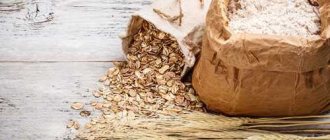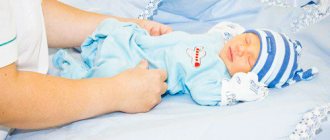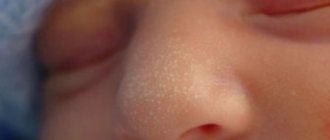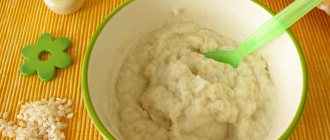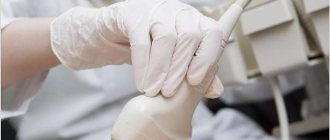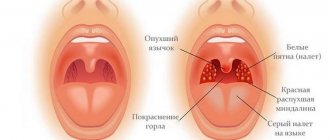For most young mothers, diathesis usually refers to red, flaky and itchy spots on the baby’s cheeks. In fact, there is no official diagnosis of diathesis. This word usually refers to atopic dermatitis or an allergic reaction of a child’s body to a particular irritant, says Lilit Dilanyan, allergist-immunologist, MEDSI Children's Clinic on Pirogovskaya. — This condition of the baby’s skin is not only hereditary in nature, but also a response to external and internal irritants, for example, poor nutrition of a woman during pregnancy, the genetic predisposition of the child’s body to allergies, a violation of the diet of the baby and mother, the presence of allergenic foods in the diet nutrition. Diathesis should not be regarded as a disease, but as a feature (tendency) of the child’s body, accompanied by an inadequate response of the body to a stimulus.”
Here are the main factors that cause the development of diathesis in a baby.
- Errors in the nutrition of a nursing mother, abuse of food that is a strong allergen.
- Hereditary predisposition: if one of the parents suffers from allergies, the risk of diathesis in the infant increases.
- Child intolerance to cereals or BKM.
- Too early or ill-chosen complementary foods.
- Problems with the child's digestive system. Violation of the composition of intestinal microflora.
- Infections.
How does allergic diathesis manifest?
The clinical picture of diathesis, according to Lilit Dilanyan, varies depending on the age of the child and the characteristics of the manifestation:
- Children from birth to the end of the neonatal period experience diaper rash, redness of the skin, small rashes on the face, scales on the forehead and eyebrows, and seborrheic crusts on the head.
- In infancy, scabs and crusts formed from scratching due to severe itching.
- With poor treatment of diathesis in the second half of life, a milky scab turns into an eczematous lesion of the face (infantile eczema).
- In children from 2 to 3 years of age, untreated diathesis provokes the development of true allergic reactions and diseases.
- In older age, neurodermatitis and eczema are often combined with bronchial asthma, urticaria, and angioedema.
Causes of diathesis in children
When my one-month-old daughter, who was on breastfeeding, suddenly developed a rash, itching and yellow scales on her head, I was at a loss, initially deciding that it was baby heat. It was a mystery where the yellow “crusts” on the head of a child who was bathed every day came from. To my surprise, the therapist who came diagnosed that this was a common diathesis in infants (ECD, or weeping diathesis). It is dangerous because through these combed microcracks in the skin, a more dangerous infection can penetrate there.
As a normal mother, I immediately had several questions: “How does diathesis appear in infants, and what kind of animal is this?” - after all, my baby is exclusively breastfed. The second question: “How to treat diathesis in an infant effectively once and for all.”
Diathesis occurs in a tiny organism in the form of a violent reaction of the immune system to food proteins entering its fragile body. What could be the trigger for this? It turned out that to this day there is no exact reason for the appearance of diathesis. As usual, there are some factors that could become catalysts:
- Heredity. Yes, yes, if you or your spouse are susceptible to food allergies, your baby received this “gift” at the genetic level.
- If your diet during pregnancy included a lot of allergenic foods.
- Toxicosis in the last trimester.
- Diseases suffered during pregnancy that were treated with medication.
- Introduction of early complementary feeding
- Unsuitable environmental conditions (climate, ecology, allergens in the air) Such a violent reaction of the body is due to the fact that the digestive system is not fully developed and it simply lacks many enzymes.
The therapist accused me of being 22. summer mother in poor nutrition, and the fact that I am the cause of the rash on my baby’s body. The doctor explained that diathesis in children often occurs because nursing mothers introduce allergens to their children with each breastfeeding (every 2-3 hours). Before the child’s immunity has time to “overcome” the foreign protein, a new batch arrives a couple of hours later. Allergens can be:
- Eggs
- Chocolate
- Nuts
- Citrus fruits, strawberries, exotic fruits
- And, oddly enough, milk.
Looking ahead, I will say that later, when after a week or two the diathesis did not disappear, she added to the list, explaining that perhaps the newborn’s gastrointestinal tract reacts to:
- Everything red (tomatoes, apples, including sauces containing tomato, borscht)
- Bold
- Spicy.
- Anything that contains sodium glutenate (flavor enhancer)
- All containing preservatives and artificial colors.
Now that we know the reasons for the appearance of diathesis in newborns and infants, let's move on to the next question.
Treatment of allergic diathesis
Due to the variety of causes and mechanisms of development of diathesis, there is currently no specific treatment. “In each individual case, therapy is selected individually, depending on the severity of skin manifestations, the duration of manifestations and the characteristics of each baby’s body,” says Lilit Dilanyan. “But in any case, treatment is carried out comprehensively, taking into account the characteristics of the manifestations and certain factors.”
Comprehensive treatment of diathesis includes:
- elimination of suspected and identified allergens; drug therapy;
- normalization of the child’s general regime;
- normalization of the diet of mother and child;
- sanitation of foci of chronic infection and subsequent clinical observation of the child.
Nutrition
If your baby suffers from atopic diathesis, try to maintain breastfeeding for as long as possible, because breast milk is the best nutrition for a baby. However, even with natural feeding, there can be exacerbations due to the diet of the nursing mother, if she indulges herself in potentially dangerous foods or violates the diet. To feed artificial babies, the pediatrician will recommend using an adapted formula (fermented milk, partially or completely hydrolyzed).
Thus, one of the most important points in the therapy of a child suffering from diathesis is the correction of nutrition for both the baby and the mother. If the baby is breastfed, the nursing mother should reconsider her diet.
Excluded from the diet:
- all products containing protein from cow's milk and the milk of other mammals, beef;
- highly allergenic products - eggs, peanuts, nuts, fish, seafood, soy; products that often cause both allergic and non-immune (“false allergic”) reactions (caviar, mushrooms, honey, chocolate, coffee, cocoa, citrus fruits, kiwi, pineapples , avocado);
- broths, marinades, salty and spicy dishes, canned food, smoked meat and fish, spices;
- products containing artificial colors, flavors, preservatives;
- carbonated drinks, kvass;
- products containing histamine liberators and histamine: sauerkraut, radishes, radishes, fermented cheeses, ham, sausages, smoked meats, pickles, marinades;
- products that irritate the gastrointestinal tract and change the taste of milk: onions, garlic, radishes, radishes.
“To determine what could cause an allergic reaction in a baby, it is recommended to keep a food diary,” says Lilit Dilanyan. - It records the date, quantity and time of food intake, the name of the product, composition, method of preparation, the child’s well-being, the appearance of itching, skin rashes, changes in the general condition of the baby. This record is very important for making a diagnosis and identifying the allergen. During the remission period, foods are introduced into the diet one at a time, in gradually increasing quantities, with mandatory registration of all symptoms. If the manifestations of diathesis persist and the child is on artificial feeding, it is necessary to change the formula and find an alternative nutritional one based on highly hydrolyzed protein. If the condition does not improve within 2 weeks when taking a formula based on highly hydrolyzed protein, it is recommended to switch to an amino acid-based diet.”
Complementary foods are introduced to babies with allergic diathesis a month later. It starts with a puree of white and green vegetables (zucchini, cauliflower, squash, light pumpkin). The second stage of complementary feeding is dairy-free and preferably gluten-free porridge. It is recommended to expand the diet with meat dishes based on lean pork, rabbit, turkey or lamb. Gradually offer your baby products of the second category of allergenicity (in minimal quantities), but keep a close eye on the reaction.
Treatment: techniques and principles
In view of the consequences that diathesis can lead to, it is better to begin treatment of infants immediately, when the first symptoms appear. First of all, it is important to take into account the correctness and completeness of the diet and proper care of those skin areas that are already susceptible to allergies. All kinds of advertised ointments, gels and creams should be treated with caution and only after the advice of a certified pediatrician.
In order for the treatment of a newborn child to bring results, it is necessary, first of all:
- exclude allergenic foods from the diet of the mother and/or baby;
- use enzyme preparations (after consultation with a doctor);
- use special medications that eliminate redness and itching (they are prescribed by a pediatrician or dermatologist);
- bathe the baby in herbal infusions, take baths from celandine and string, potassium permanganate and oak bark, take baths together with the baby in water with sea salt.
The main thing that a nursing mother needs to do is to follow a strict diet, make sure that the amount of water consumed (pure water, not in the form of tea, compote or soup) is sufficient, completely eliminating harmful foods such as peanuts, smoked and sausage products, orange and red fruits, chocolate, dairy and fermented milk products. If the child is already eating on his own, switch him to water porridges and crackers, and steamed food. It is better to pre-soak cereals, and stew or bake semi-finished products.
Anna, 27 years old: My son had severe diathesis. At first there was just redness on the cheek and leg, then it developed into weeping wounds that did not even crust over. On the advice of the pediatrician, I gradually eliminated all fresh vegetables and fruits, all sweets, fermented milk and fried foods. But the situation only got worse. Until I spoke to a lactation consultant. She advised taking sea salt baths with the child every day to heal wounds. And in order to avoid diathesis, she told me to drink a glass of clean water every time before meals, two glasses of water in the morning on an empty stomach and a glass of water before bed. She explained this by saying that diathesis arose due to the fact that the child did not have enough fluid and his intestines could not cope with the absorption of milk. And she told me to eat so that live (not thermally processed) food was at least 40% of the diet. A month later the diathesis went away and never returned.
You should be wary of traditional medicine advice that advises giving your baby crushed eggshells, plant roots, herbs, etc. Medicinal herbs can provoke even greater allergies when consumed orally and uncontrollably. And salmonella can enter a child’s body with eggshells.
Drug treatment may include taking antihistamines, probiotics, immunomodulators and sedatives as recommended by a doctor.
Baby skin care
The skin of a baby, especially one suffering from allergic diathesis, needs regular care. In the morning, as well as after each bowel movement, the baby should be washed: rinse the genitals, skin folds in the groin, and buttocks under running water (temperature + 34-37C). Hand movements and the direction of the water stream should be from front to back so as not to contaminate the baby’s genitals with particles of feces.
Diapers should be changed quite often - 4-6 times a day: after bathing, before feeding, and also after each bowel movement. Staying in a dirty diaper for a long time can cause inflammation on the skin. If a rash does appear, use special protective creams that will relieve irritation. If your baby is allergic to regular disposable diapers, you can use special ones with a hydrophilic cotton base.
Give your baby regular air baths: let him be without a diaper for some time. Fresh air is very beneficial for baby's skin.
A mandatory ritual for caring for a baby is bathing. They are needed both to maintain hygiene and for the general health of the body. Baths harden, promote good appetite and restful sleep. They begin to accustom the baby to such procedures on the 10-14th day of life - after the umbilical wound has healed. The ideal time for a bath is before the last feeding in the evening. The duration of water procedures in the first month of life is on average 10 minutes. For a child suffering from diathesis, baths with bran, decoctions and herbal infusions (chamomile, string, oak bark) can be useful. However, only a doctor should prescribe them. Keep in mind that plant components themselves can cause an allergic reaction. It is better to use baby soap or foam no more than twice a week. Frequent baths with special bathing products dry out the baby's very sensitive skin.
How to treat diathesis in infants
The forms and causes of the disease directly affect how the treatment of diathesis in infants will be organized. At the first signs of diathesis, parents should contact their pediatrician. He will prescribe a diagnosis. After receiving the research results, the doctor will choose the appropriate technique, prescribe adsorbents, antihistamines and enzyme preparations. Doctors often advise using folk remedies to get rid of inflammation on the skin of a newborn. Chocolate, fish, eggs, red vegetables and fruits, and citrus fruits are excluded from the diet.
Medications
Fenistil
Qualified treatment and proper care for your baby will help you quickly get rid of the signs of diathesis. For antihistamine medications, the doctor may prescribe Fenistil drops or gel. This drug can be taken by newborns over 1 month of age. The medicine works very quickly. Relieves itching and swelling, eliminates rashes on the baby’s face. Fenistil in drops is prescribed orally three times a day, and the gel is applied to the affected areas several times a day, depending on the severity of the disease.
Bepanten Plus
A good remedy against diathesis is Bepanten Plus cream or ointment. The ointment is absorbed into the skin faster, but costs an order of magnitude more. The active ingredient dexpanthenol, when it gets on the skin, is transformed into vitamin B5. It quickly heals and restores the child's skin. This product is allowed to be used by newborns from the first days.
Sudocrem
A traditional drug that can cure diathesis in a newborn is Sudocrem. It has an antimicrobial, drying, astringent effect. Soothes inflamed skin, relieves itching. Allowed to use from birth.
Folk remedies
You can reduce inflammation, eliminate itching and redness using folk remedies. Bay leaf gives a good effect. You can prepare a decoction, infusion or ointment at home without spending a lot of time and effort.
- Brew 15 g of bay leaf with 2 liters of boiling water and boil for another 15 minutes. Then the broth is filtered and poured into prepared bathing water. The baby is bathed in it for 10-15 minutes. After washing, the skin is carefully blotted with a towel and lubricated with oil. Such baths are arranged every day for two weeks.
- 2 pcs. bay leaf, poured a glass of boiling water, leave for 6-8 hours. Then filter and drop a teaspoon into the baby’s mouth three times a day.
- The bay leaf is crushed in a coffee grinder and poured with vegetable oil (2 tablespoons of oil per 1 piece of leaf). The resulting mixture is kept in a water bath for 30 minutes. Lubricate the baby's body twice a day.
The sequence for diathesis is considered one of the most effective folk remedies used for infants. It’s not for nothing that it’s called baby grass. In combination with celandine, violet, chamomile, calendula, and strawberries, the healing properties of the string are greatly enhanced.
- A decoction of chamomile, string, calendula and celandine for bathing: 2 tbsp. strings, the same amount of chamomile, calendula and celandine are poured with boiling water. Boil for 5 minutes. The finished broth is filtered and added to the bath before bathing the child.
- If parents do not know what to apply to their child’s diathesis, other than pharmaceutical drugs, they can prepare an excellent inexpensive remedy at home. Crushed violet leaves, string and dry strawberry leaves are mixed in equal proportions. Pour boiling water over it and boil for about 10-15 minutes. Then leave for 2 hours, filter and give the baby a teaspoon three times a day.

